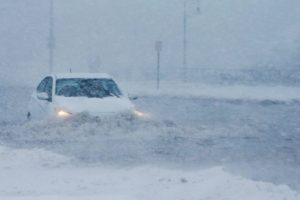Washingtonpost.com 4jan2018
By Doug Struck and Mark Berman January 4 at 6:15 PM

BOSTON — It began with a gentle dusting, a flutter of flakes falling on this city already enduring a bitterly cold winter.
“This isn’t bad,” said Richie Bianchino, 30, after he parked his car Thursday at a covered mass transit garage. He was wearing a hoodie and no gloves. “We’ve just had a bunch of days near zero. This feels good.”
The peaceful start didn’t last. As the day wore on, the mammoth winter storm churning up the East Coast had pummeled Boston with driving snow and painful sleet as it continued marching north, sweeping across population center after population center. As much as 14 inches fell in Greater Boston on Thursday, leaving more than 24,000 without power by late afternoon as the storm caused what officials called a “historic high tide” to flood coastal towns.
The storm dumped more than a foot of snow in areas from Virginia to New Hampshire, swamping millions with a one-two-three punch of heavy snowfall, gusting winds and coastal flooding. All across the Northeast, routines of daily life were brought to a standstill Thursday as schools and offices shut down, roadways were left impassable and nearly 5,000 flights were grounded. Hundreds of flights scheduled for Friday were called off as well
In New England, officials worried not only about the snow, but also the wind gusts — topping 40 mph at Boston’s airport and reaching as high as 76 mph on Nantucket — that brought down power lines, leaving people without heat or power before the temperatures are forecast to plummet on Friday and into the weekend. A region already weary of the cold — the high temperature has not been above freezing since Christmas — will now face at least a couple days below zero.
“After the storm’s over, the commonwealth will immediately see a return to the bitter cold temperatures of the past few days, which will cause freezing conditions on top of the storm,” Gov. Charlie Baker (R) said at a briefing Thursday. “We’re all hardy New Englanders, but it’s pretty important for everybody to pay attention and be prepared.”
The storm strengthened Thursday into a “bomb cyclone,” the dramatic name for what happens when a storm’s pressure plummets as it explosively intensifies. Though forecasters said this storm was among the most powerful ever observed on the East Coast, much of the cyclone actually remained in the Atlantic Ocean as it lashed the coastal states.
After the snow has moved out of New England by Friday, arctic air will descend upon the Eastern Seaboard, plunging temperatures into the single digits and teens in the Mid-Atlantic, Northeast and New England.
When the flakes fell in the Northeast on Thursday — a day after Southern states got an unusual coating of snow — some welcomed the sight. In New York, while flights were suspended at both LaGuardia and John F. Kennedy International airports, the Times Square area was clogged with snow as wind whipped the flakes across the bright electronic billboards looming overhead. Tourists still showed up, taking selfies and throwing snowballs despite the harsh conditions.
Casey and Austin Sergent, a brother and sister from Columbus, Ga., braved the elements to line up at the TKTS booth so they could purchase tickets for a Thursday matinee of “The Phantom of the Opera.”
“It’s beautiful,” said Casey, 20, who was visiting New York for the first time. “I’m amazed that everything functions here, unlike Columbus, where everything shuts down when it snows.”
Not everything functioned, of course. School systems from Florida to Massachusetts were closed, canceling classes in major school districts including the District and its suburbs, Baltimore, Philadelphia, New York and Boston. Government offices closed down or let employees come in late as they trudged through snow, slush and salt.
In New York City, at Tom’s Restaurant — the diner with an exterior made famous by the show “Seinfeld” — cabdriver Brooks Sissay gave himself the day off. He hunkered down at the diner’s counter with a cup of coffee and a pile of newspapers.
“I’m 68 years old and I can’t do it any more,” Sissay said. “I might have driven in the snow when I was younger, but not now.”
Brian Robinson, escorting a group of high school students from West Texas on a class trip to Boston, wanted them to soak up the frigid climate while they were there.
“We want as much snow as we can get and as cold as it can get,” Robinson said. “It’s the experience.”
The students shared that enthusiasm. “I’ve never seen snow before!” exclaimed Erynne Turner, 18, a student. “We made a snow angel this morning,” said Hannah Glass, also 18.
Authorities pleaded with people to stay off of roads due to the icy conditions. At least three deaths have been attributed to the storm. North Carolina Gov. Roy Cooper (D) said Thursday that three men died, all of them in trucks that overturned. State troopers have responded to more than 1,000 calls since the storm began, more than 700 of them involving car collisions, Cooper said.
“With the freezing temperatures, the black ice will be an ongoing concern through the weekend,” Cooper said at a news briefing. “You can make the job of our first responders and our road crews a lot easier by staying off the roads unless it is absolutely necessary.”
First responders found difficult conditions when they tried heading out Thursday. About 35 miles south of Boston, fire officials in Duxbury, Mass., said a firefighter was taken to a hospital after crashing while responding to a report of a building fire. Fire officials there also were making “several water rescues,” the department said.
The storm pushed historically high tides to flood over coastlines in Massachusetts, New Hampshire and Maine, authorities said. Streets along the Boston coastline were awash by midday, flooding that came as the tide swelled so high that some vessels were brought up to street level alongside the city’s Seaport area, according to the Massachusetts State Police.
Water flowed down the streets in Scituate, Marshfield, Plum Island, Dorchester and other Massachusetts communities, and police and fire personnel carried people get out of water-stranded cars and low-lying apartments.
“We were in the office when all of a sudden the water started coming in,” said Gina Cameron, 36, who works at the Boston Harbor Cruise company at Boston Harbor. “We had to scramble to get the computers up high.”
Officials in New England attacked the snow cleanup with urgency, eyeing the sharp drop in temperatures that would quickly turn slushy snow coating the roads into ice. Most people around Boston huddled in their homes, but those who live on the streets looked for safety.
In the St. Francis shelter in downtown Boston, Bo Revera, the shelter manager, was a man in motion. “We just saved a guy’s life with Narcan, we recovered a stolen cellphone, and we’re serving lunch,” he said, referring to the use of an opioid overdose antidote drug, as men and women streamed through the metal detector seeking a hot meal.
“It’s just too bad out there,” said Troy Savage, a 21-year-old who said he has been on the streets for two years.
In Cambridge, Mass., normally busy sidewalks were largely empty. Dry cleaners and beauty shops were closed, while Inman Square Hardware was busy Thursday morning with people buying rock salt and shovels. At the nearby 1369 Coffee House, lifelong Cambridge resident Terry Carter came in for his hot caramel apple cider before he expected to shovel snow for others later in the day.
“I’m used to this weather,” Carter said. “This is like the perfect day.”
Record cold temperatures are affecting much of the U.S. The weather may be brutal, but it can also be beautiful. (Taylor Turner/The Washington Post)
Despite the cold and ice, it was business as usual for some stores in Hartford, Conn., where bright “OPEN” signs were the only things visible amid blinding snow. Pauline Taylor, a CVS employee, had been working at the store since 7 a.m. Thursday and was shrugging off the snowstorm as just another winter day in New England.
“I got my boots, big coat and long johns. It’s fine,” Taylor said. “We never close unless the electricity goes.”
Jesse Macauley, a 37-year-old student from New York City, sat at the bar Thursday at the Burlington Airport, about to catch one of the few flights out of Vermont. He had been in New England visiting family and was headed to Lake Tahoe, where he grew up. He felt as though he was escaping another arctic blast — which is expected to drop temperatures 40 degrees below normal by the weekend — but much of the past week or so has been frigid in Vermont. It was a relatively balmy 18 degrees outside the airport on Thursday.
“I do feel like I’m escaping,” he said. “This is the coldest weather I’ve ever experienced in my life. I never thought 23 above zero would be a pleasant temperature.”
Berman reported from Washington. Jason Samenow, Dana Hedgpeth and Lori Aratani in Washington; Katie Zezima in Burlington, Vt.; Danielle Douglas-Gabriel in Hartford, Conn.; Vera Haller in New York; and Karen Weintraub in Cambridge, Mass., contributed to this report.
